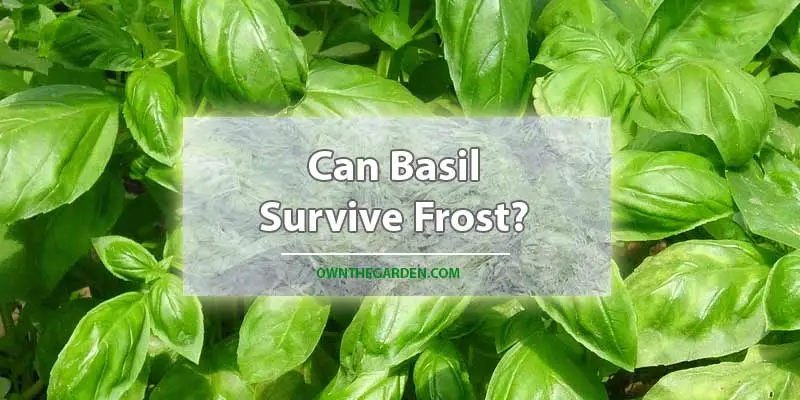Basil is a popular herb that’s used in everything from pasta to pesto. It’s often grown as a potted plant or in the ground, but what happens when it gets too cold outside? Can basil survive frost?
Yes! Basil is a hardy plant that can withstand cold weather. In fact, basil actually prefers cooler temperatures to warmer ones. That being said, don’t worry if your basil gets caught in a sudden freeze—it’s unlikely to survive long-term damage from frost. But if you catch the growth at an early stage, before it has formed significant roots and leaves, then there’s no need for concern.
What Will Happen To My Basil After a Frost?
Frost is essentially water in its solid form: when temperatures drop below 32 degrees Fahrenheit (0 Celsius), water molecules in the air form ice crystals that fall out of the sky as snowflakes or sleet pellets (depending on whether there’s moisture present).
If this happens while leaves still have dew on them or are wet from rain, they could become damaged by freezing temperatures; however, basil plants can withstand short periods during which they struggle through frozen soil without sustaining permanent damage.
How Tolerant Is Basil To Cold Weather
In the summer, basil is a warm weather plant and prefers temperatures between 70 and 85 degrees. But in the winter, basil can tolerate temperatures down to 40 degrees.
When it comes to frost tolerance, basil is not very tolerant at all. The best you can hope for with your basil plants in cold winter weather is that they’ll survive until spring. It’s not uncommon for herb gardeners to lose their entire crop of basil after a hard freeze!
How To Protect Your Basil From Frost
If you want to keep your basil safe during a frost, there are a few ways to do it. One option is to bring the plant inside. If your home is warm enough, this can be an ideal solution—just make sure you get rid of any insect pests first!
Another great way to protect your basil from freezing temperatures is by bringing it in a container and setting it on a sunny window sill. This will allow the plant plenty of light while keeping its roots nice and warm as well as providing some insulation against temperature fluctuations outside.
If you don’t have space indoors or just prefer having plants outdoors in general, another good option would be placing them under cover somewhere else like a greenhouse or other sheltered structure such as an outdoor shed or barn (if there are any nearby).
You may need more than one layer for added protection if there are gaps between each surface; however, if this isn’t feasible then placing some hay around the base of your plants could help insulate them from cold drafts which could otherwise damage new growths that might develop later on down through springtime months ahead!
Caring For Basil During The Winter
If you live in a place where the winter is cold, but not too cold, your basil plants may survive the first frost if you care for them properly.
At the start of autumn, cut back any flowers that have already bloomed and remove any leaves that are yellowing. This will help keep your plant healthier. Then cover the plant with mulch to protect it from the cold.
In addition to protecting your basil from freezing temperatures, this also allows you to harvest more leaves because they won’t be destroyed by frost or snowfall.
Can I Overwinter Basil?
Yes, basil can be overwintered indoors or outdoors.
- Overwintering basil in a greenhouse is the easiest way to keep it alive over winter. When you bring your plants into the greenhouse, place them near a south-facing window where they will get good light but not too much heat. Keep them well-watered and fertilized through their dormant period.
- Basil can also be left outside as long as they are protected from cold temperatures by a structure such as a tunnel or a cloche (a covering that keeps in the heat, moisture, and warmth). These coverings will help protect your basil from frost damage during the colder months of late autumn and early winter, but will still let enough sunlight through for photosynthesis to occur so that your plant does not die completely!
What Temperature Is Too Cold For Basil?
Basil is a tropical plant and can withstand temperatures as low as 40 degrees Fahrenheit without much damage. However, if you let it get colder than that (and your plants aren’t protected), they will freeze and die.
Although winter-hardy varieties of basil are available in many areas of North America, your best bet for growing this herb outside during the colder months is to bring it inside during times of frost or freezing temperatures.
If you do choose to grow basil indoors all year round, keep in mind that its growth rate will slow down considerably at lower temperatures—so don’t expect it to thrive as it would outdoors!
Conclusion
There are many ways to protect basil from frost, and if you follow the tips we’ve outlined in this post then you should be able to keep your plants safe from cold weather. The most important thing to remember is that your basil will not tolerate frosty temperatures for long. So if you have a few leaves that start turning black or brown on them, it’s time to give them some warmth or move them indoors.


